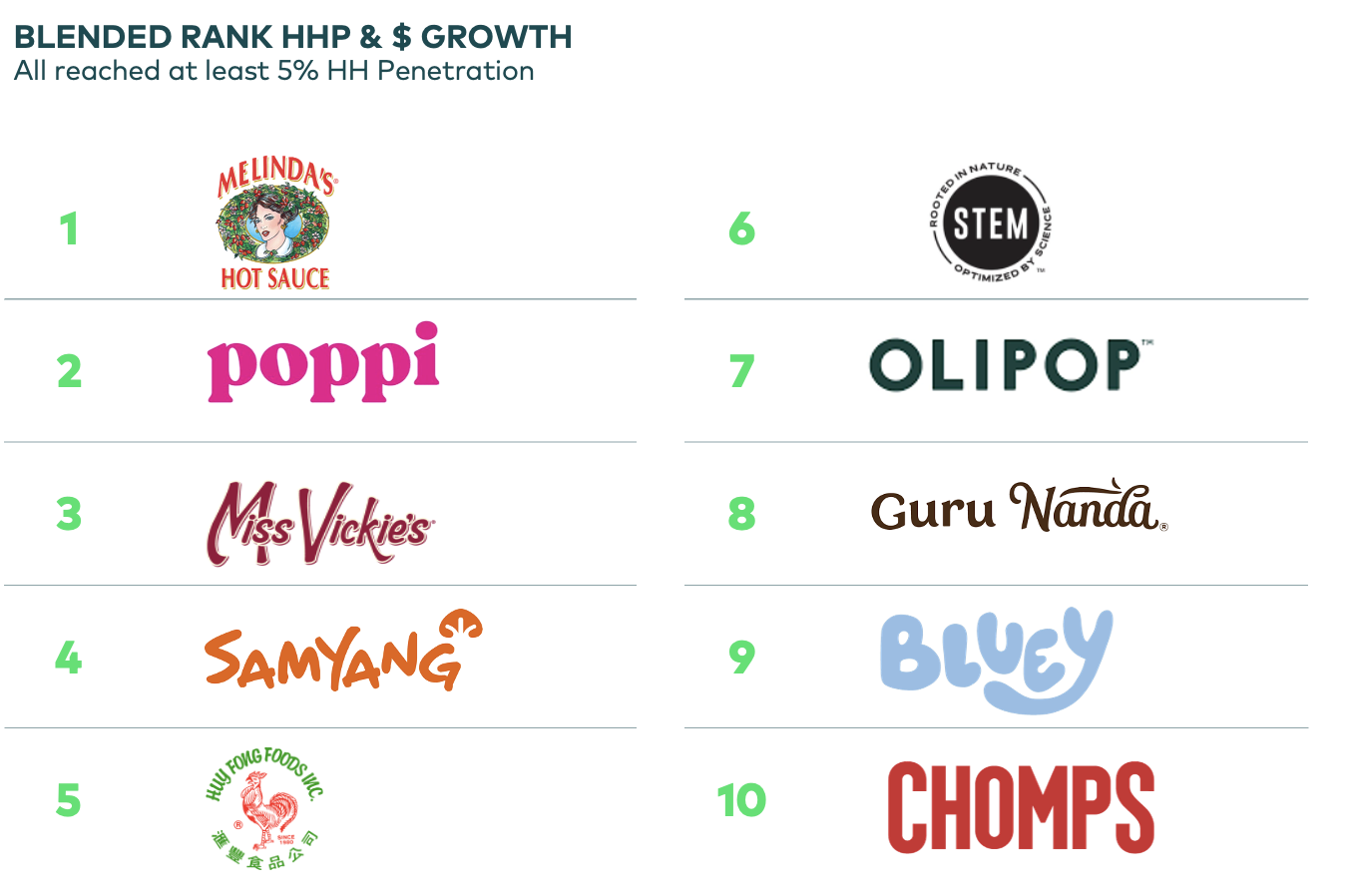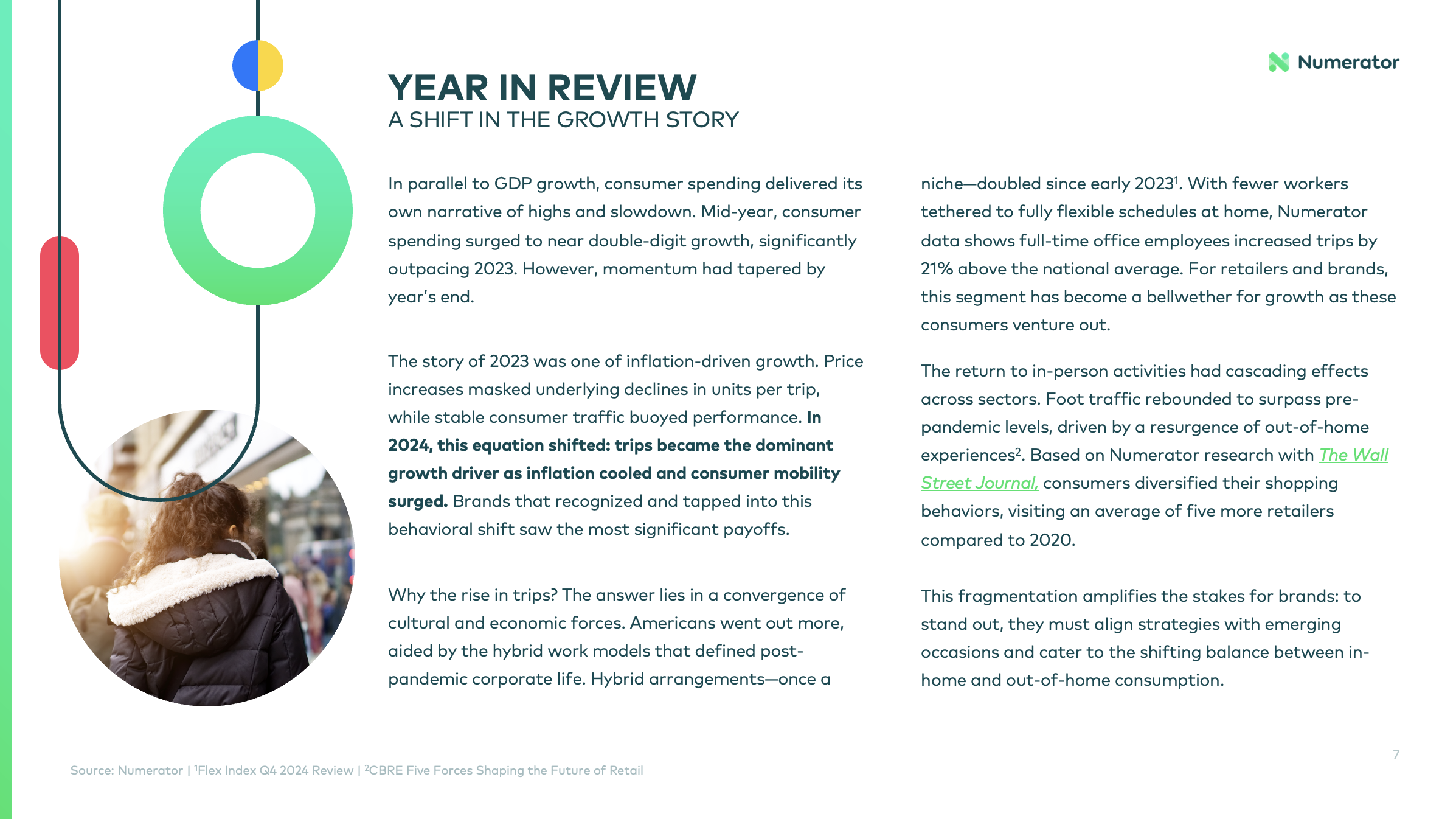Numerator Visions
Consumer trends
for 2025.
Welcome to our 2025 release of Numerator Visions, an annual perspective that looks back at consumer trends during the past year, provides forward-looking insights into the year to come, and serves as a starting point to prepare for the future.
Every year, our report shares several visions on what to expect for the top US consumer trends and how industry leaders and executives should act. These visions are drawn from our comprehensive understanding of the consumer, which we gain through Numerator’s full suite of products and industry expertise.
Year in Review: A Shift in the Growth Story.
When we trace back to the end of 2023, most everyone from economists to business leaders couldn’t have expected consumers to maintain spending at elevated levels. However, the US experienced several tailwinds:
- Disposable personal income grew by 5.1% year over year ending Q3’2024.
- Consumer price inflation came down from 3.3% at the start of the year to 2.7% by the end of year.
- Despite a softening labor market, U.S. employers added 2.2 million jobs – a smaller gain than prior years but above 2019 levels.
What is the biggest consumer trend in 2025? For one, it’s the delicate balance between financial caution and the desire for meaningful indulgences. Inflation may have cooled, but it hasn’t erased the lingering price sensitivity among consumers even though income has grown. Yet, even amid this cost-conscious mindset, people are still finding ways to spend on experiences that bring joy. Limited-service restaurants have seen steady growth as consumers gravitate toward affordable indulgences while groceries stay stable. Meanwhile, general merchandise categories like sports equipment and apparel reflect a cultural appetite for mobility and leisure.
This interplay of pragmatism and indulgence is also reflected in the shifting drivers of consumer spending. In 2024, for example, consumer expenditures saw a significant boost mid-year, driven by increased trips and greater mobility. Hybrid work arrangements also played a key role, with full-time office workers logging 21% more trips than the national average. These behavioral shifts underscore how changes in daily routines and macroeconomic forces can ripple through entire industries. For leaders, it means understanding the touchpoints and emerging occassions to capture their consumer.
What drove consumer choices in 2024?
To understand the path ahead, Numerator conducted an analysis of consumer behaviors through a max differential, revealing four primary influences in how consumers purchase. As brands look to 2025, aligning strategies with these influences can help build on growth. Whether through financial flexibility, product innovation, or retail partnerships, the future belongs to those who can adapt with agility and insight.
Explore these four influences to get a taste of what is in the full report—providing actionable guidance for brands seeking to navigate uncertainty, capture growth, and thrive in an ever-evolving consumer landscape.
The Consumer State
Numerator’s analysis with the Federal Reserve highlights a stratified recovery in consumer spending. Middle- and high-income households have driven economic recovery, while low-income consumers only recently returned to mid-2021 spending levels. Industries like consumer packaged goods, general merchandise, and limited-service restaurants are feeling the effects. For brands, affordability remains essential for lower-income consumers, while premium products offer opportunities with higher-income groups.
Consumer optimism is rising, with November 2024 showing the highest sentiment levels since early 2022. Yet this optimism is not universal, as younger and multicultural consumers remain more cautious. Positive outlooks are already shifting behavior: consumers with improved confidence are less likely to cut back on dining out, travel, or entertainment, signaling opportunities for service-oriented industries.
Policy changes, such as SNAP adjustments and potential tariffs, could reshape spending. Tariffs may push prices higher in categories like electronics and home goods, prompting over half of consumers to stockpile goods or favor U.S.-made alternatives. These trends present opportunities for brands to emphasize domestic production and affordability.
The Continued Health Imperative
What is the biggest consumer trend in 2025? The answer likely lies in the continued rise of health and wellness. From probiotic sodas to protein shakes, consumptive nutrition is becoming a preferred solution for health-conscious consumers. Younger generations, in particular, are driving this trend, opting to obtain nutrients through their diets rather than supplements. In fact, 36% of Americans prefer getting their nutrients through food– up by 9 percentage points year over year.
Yet, the health narrative isn’t without its complexities. A growing income-driven divide has emerged: lower-income households are scaling back on physical health investments such as getting their annual physical and taking vitamins & supplements, focusing more on mental wellness instead.
Meanwhile, higher-income consumers are maintaining their emphasis on fitness and physical health. These dynamics are reshaping categories like pet wellness and health-centric beauty products, which remain among the most resilient sectors.
Winning Brands: Growth, Trends & Tactics
In a complex consumer landscape, growth requires both creativity and precision. Numerator’s analysis of thousands of brands identified the Top 100 fastest-growing based on penetration and sales growth. The results point to two critical levers for success: attracting new shoppers and driving frequent repeat trips.
On average, these top brands increased household penetration by 2.5 percentage points, with household spending rising 7.6%. Notably, growth was driven by repeat trips, with winning brands increasing trips per household nearly five times faster than competitors—a clear sign that occasions and repeat purchases fuel sustainable growth.
Numerator’s deep dive into the top 10 fastest-growing brands of 2024 highlights how these leaders connect with emerging audiences and cultural trends. The list spans diverse names like Melinda’s Hot Sauce, wellness brand Guru Nanda, and Bluey, a cultural phenomenon beloved by families. These brands excel by overindexing with younger, multicultural households, particularly on the West Coast.

Meeting Consumers Where They Are
The retail landscape in 2025 is more fragmented than ever, with consumers shopping across an increasing number of channels. Traditional sectors like drug stores and pet stores are struggling to maintain market share as shoppers shift behaviors. Promotions have surged to record levels, and e-commerce is now synonymous with value. Loyalty-driven programs like Walmart Cash and Target Circle are redefining how consumers engage with brands, while sectors like drug stores have cut promotions by 20–30%, driving purchases online to platforms like Amazon.
Despite e-commerce’s dominance, brick-and-mortar retail could rebound as consumers seek experiences alongside shopping. Retailers must create engaging, experiential environments to capture this demand. Meanwhile, private label is transforming, offering premium products like Walmart’s bettergoods and CVS’s Well Market that rival name brands in quality, highlighting how these innovations appeal to consumers seeking affordable indulgences.
Download the full report and watch the webinar on-demand to see all the insights.
In the full report and webinar, you will discover more about these top four consumer trends and what it means for your brand. More insights include:
- How potential policy shifts like SNAP, tax credits and tariffs could affect consumers
- What could a baseline real GDP growth scenario look like in 2025
- What are the trending macronutrients consumers care about
- Which retailers do the fastest-growing brands lean on







